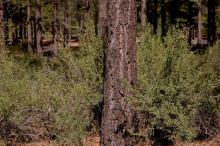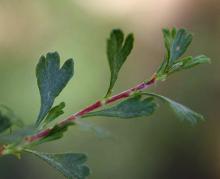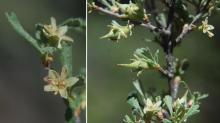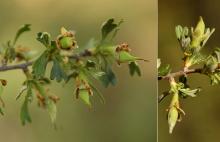Purshia tridentata
Common name:
Bitterbrush
Antelope Brush
Antelope Bitterbrush
Pronunciation:
poor-SHE-ah tri-den-TAH-ta
Family:
Rosaceae
Genus:
Type:
Broadleaf
Native to (or naturalized in) Oregon:
Yes
- Deciduous, sometimes evergreen, shrub, erect, heavily branched, 2-10 ft (0.6-3 m) tall, usually 3-4 ft (0.9-1.2 m). Leaves simple, alternate, but commonly clustered on spur shoots, 0.6-2 cm long, wedge-shaped with a 3-lobed (toothed) apex, margins rolled under (revolute), green to grayish-green and finely pubescent above, white to grayish-white and pubescent below, very short petiole. Leaves are non-aromatic, in contrast to Big Sagebrush (Artemesia tridentata) which has similar shaped foliage. Flowers small, 8 mm across, yellow, tubular, borne singly. Fruit single or paired achenes, elliptical or tear shaped, 3-13 mm long, bitter tasting.
- Sun. Dry site, it is drought resistant; has a very long tap root.
- Hardy to USDA Zone 3 Widely distributed, from British Columbia east of the Cascade Range through Washington and Oregon; in the Klamath, North Coast, Cascade, and Sierra Nevada ranges of California; southeast into western Montana and throughout the Rocky Mountains; in the Great Basin; and in Arizona and New Mexico. Two ecotypes, (a) multiple-stemmed, reclining (decumbent) plants, most commonly found at higher elevations, and (b) single-stemmed, columnar plants. A similar species is P. glandulosa (syn. P. tridentata var. glandulosa), Desert Bitterbrush, its leaves are green, hairless or nearly so, and they have depressed glands on inrolled leaf edges, and the shrub is evergreen.
- tridentata: three toothed, the leaf apex.







